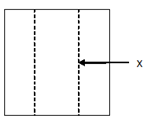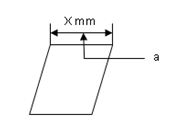This set of Tricky Engineering Drawing Questions and Answers focuses on “Different Types of Lines – 2”.
1. In engineering drawing, which type of line indicates that there is a change of plane?
a) Continuous thin wavy
b) Long chain thin
c) Continuous thick
d) Medium thick short dashes
View Answer
Explanation: In engineering drawing, a change of plane is indicated by drawing continuous thick lines. Continuous thin lines are used for indicating dimension line, hatching line, revolved section, etc. Long chain lines are used to indicate center line, cutting lines.
2. Which of the following lines are used to show that the object is cut and then viewed?
a) Hidden lines
b) Leader lines
c) Centre lines
d) Hatching Lines
View Answer
Explanation: Hatching lines are used to show that the orthographic view is drawn after a section of the object is cut. They indicate that the object is cut and it shows the remaining solid body. Hidden lines are used to indicate holes or slots.
3. What do hidden lines in orthographic projections denote?
a) Holes or slots
b) Change of Plane
c) Position of cut
d) Centre of a circle or cylinder
View Answer
Explanation: Hidden lines denote those parts which cannot be seen when viewing the object. They are used when there are holes or slots in the object if they cannot be viewed directly. Change of plane is indicated by outlines. Position of cut is denoted by section line.
4. From the fbelow figure, what is the name of the line X?

a) Outline
b) Section line
c) Hidden line
d) Hatching
View Answer
Explanation: Hidden lines are dashed lines with dashes equaling 2mm and the gap 1mm. These lines depict that there is a hole or slot i.e. no solid part is present there. Section line are long chain thin lines with thick ends.
5. What is the type of line used for line a?

a) Continuous thick
b) Continuous thin straight
c) Medium thick short dashes
d) Continuous thin wavy
View Answer
Explanation: Continuous thin straight lines are used to denote the dimensions of the object. Thin lines are used so as to distinguish between outline and the dimension line. Continuous thin wavy lines are used to indicate short breaks or irregular boundary line.
6. The axis of the cylinder or sphere is denoted by which of the following line?
a) Section line
b) Centre line
c) Hidden line
d) Leader line
View Answer
Explanation: Centre line shows the axis of the cylinder or sphere. These lines generally pass through the centre of the circle. For a cylinder, they generally are parallel to the height of the cylinder. For circles, two centre lines are drawn perpendicular to each other passing through the centre of the circle.
7. What is the standard length and width of the arrowhead of dimension lines?
a) 2mm and 2mm
b) 3mm and 1mm
c) 4mm and 2mm
d) 3mm and 2mm
View Answer
Explanation: Arrowheads of dimension lines have a length of 3mm and 1mm wide. When drawing the arrowheads the ratio, length: width is to be maintained at 3:1. The arrowheads can be drawn with length 6mm and breadth 2mm, since the ratio is the same.
8. What is the length of the short dashes of the centre lines?
a) 5mm
b) 2mm
c) 1mm
d) 3mm
View Answer
Explanation: Centre line consists of a long dash of 8-10mm, a gap of 1mm, short dash of 2mm and then a gap of 1mm. This pattern continues throughout the centre line. In the case of section line, the ends of the section line are thickened. This is how section line and centre line are different.
9. Among the following, which of the representation is wrong?
a) ![]()
b) ![]()
c) ![]()
d) ![]()
View Answer
Explanation: For proper dimensioning, it is important for the lines to meet. One line cannot be in air with respect to the other intersecting line; they should meet at some point. If the lines do not meet, dimensions will not have accuracy.
10. Which type of line is used to join the dimension line and the curve that needs to be dimensioned?
a) Leader line
b) Outline
c) Dimension line
d) Section line
View Answer
Explanation: Leader lines lead the dimension line to the curve that needs to be dimensioned. It is a bridge connecting two lines. Outlines are the main or most prominent lines of the object when viewed for drawing. Dimension lines are used to denote the particular dimensions.
11. What is the difference between the section line and the centre line?
a) The length of the long dashes
b) The length of short dashes
c) The width of the gap
d) The two ends of the lines
View Answer
Explanation: The ends of a section line are thickened so as to distinguish it from the centre line. The rest of the section line has the same thickness and dimensions as that of the centre line. The thickening of the ends in the section line is also used to denote the direction of viewing.
Sanfoundry Global Education & Learning Series – Engineering Drawing.
To practice Tricky questions and answers on all areas of Engineering Drawing, here is complete set of 1000+ Multiple Choice Questions and Answers.
If you find a mistake in question / option / answer, kindly take a screenshot and email to [email protected]
